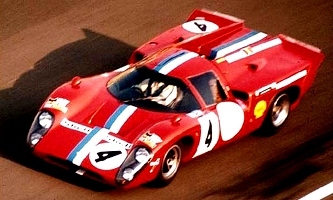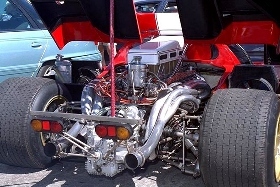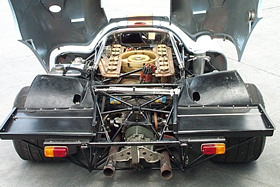
|
|





How They Compared |
By Simon Taylor and Patrick McNally (Autosport 18 June 1970) This year the two principal contenders displayed surprising similarities, even though one was air-cooled and had horizontally opposed cylinders, and the other was water-cooled and Vee-blocked. The demands of the CSI's 5-litre Group 5 regulations are naturally responsible for much of this, but it is interesting that both cars have 12 cylinders with very similar bore and stroke measurements (87 mm x 70 mm for the Ferrari and 86 mm x 70.4 mm for the Porsche, giving 4994 cc and 4907 cc respectively and almost identical piston speeds). Both engines have four camshafts, but whereas the Ferrari has four valves per cylinder, the Porsche has only two. Porsche would like to have built a four-valve engine but with air-cooling this is not at the moment practicable; next year one would not be surprised to see a liquid-cooled Porsche engine with four valves per cylinder. The Ferrari has seven main bearings and the Porsche six (although the flat-8 908 has ten). The Porsche's drive, of course, comes off the centre of the crankshaft. The Ferrari's power output is quoted as a conservative 560 bhp at 8500 rpm, with maximum torque at 5500; despite claims of over 600 bhp for the Porsche, the actual output is almost cartainly around 580 bhp at 8450 rpm; maximum torque is slightly greater than the Ferrari, but the peak of the curve is higher at 8600 rpm. |
Suspension and braking systems on both cars are very similar, and both use five-speed gearboxes, but the much more robust Ferrari chassis uses steel tubing reinforced with alloy sheet, while the Porsche has a frame of alloy tubes. Both use fibreglass body panels, but the major difference is in weight. Porsche are one of the largest users of titanium in Germany, and 3 per cent of the car's total weight is said to be made up of this expensive alloy. In scrutineering the 917s weighed in at between 810 kgs and 858 kgs, while the Ferraris were between 915 kgs and 952 kgs - so that Porsche's advantage was around 220 lbs. Just how expensive and rarefied Group 5 has become was shown by the contrast between the Ferraris and Porsches and the two examples of the car that ruled Group 5 not so long ago, the Lola-Chevrolet T70 Mk 3B. The Belgian Team VDS outfit had their red machine for Teddy Pilette and Taf Gosselin, with a 492 bhp Bonnier-Morand engine on carburetters. Mike de Udy's entry was taken over by another Mk 3B, the ex-Penske ca of the inexperienced Bahamian Robin Orme, whose co-driver was David Prophet; in practice Orme could not qualify and the car was withdrawn. |
The Lola T70 Mk 3B driven by Gustave "Taf" Gosselin/Teddy Pilette |
The engine of a Porsche 917K |
The engine of a Ferrari 512S |